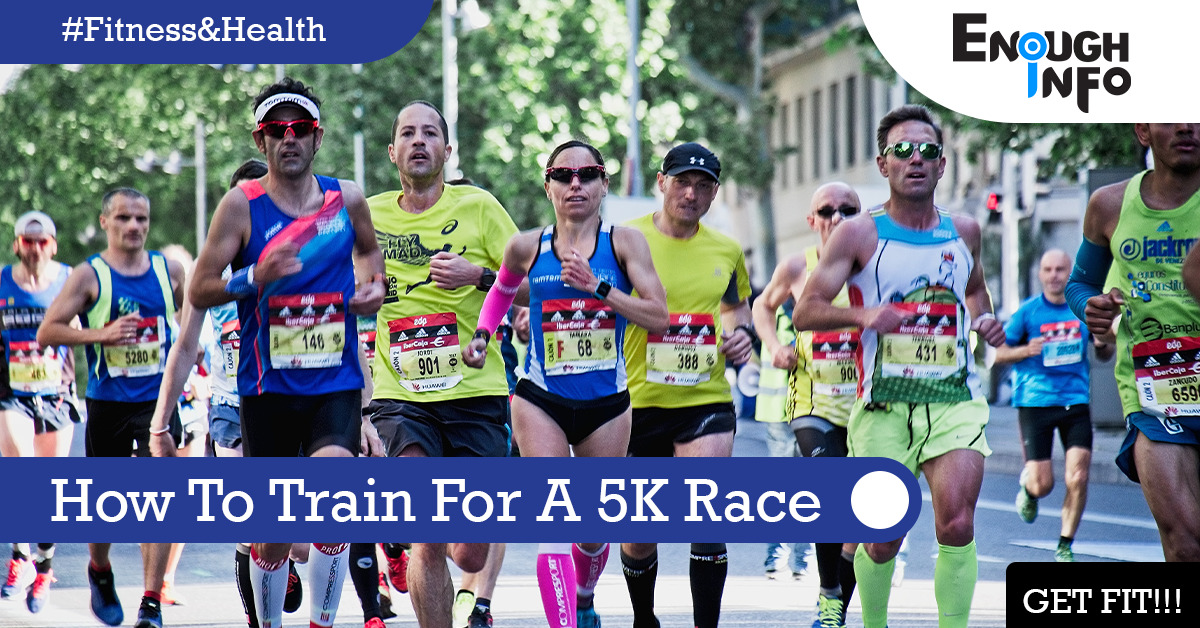
How To Train For A 5K Race: Training for a 5K race can be an exhilarating and rewarding experience, whether you’re a beginner looking to complete your first race or an experienced runner aiming for a personal best. With the right training plan and mindset, you can successfully prepare yourself for the challenge ahead. EnoughInfo.com

Read Also: How To Be A Better Sports Player
Running is one of the most accessible workouts because it doesn’t involve any expensive equipment or cumbersome machines — simply put on a pair of running shoes, load up a pump-up playlist, and get moving. If you’re a beginner runner who wants to improve your strength and endurance, following a certain plan can assist.
A 5K is 3.1 miles, and it may seem intimidating right now, but it’s completely feasible if you follow my plan.
FAQs & Answers on How To Train For A 5K Race
1. How long does it take to train for a 5K race?
The duration of training for a 5K race can vary depending on your fitness level and goals. Generally, a training program of 8-12 weeks is suitable for most beginners to build the necessary endurance and speed for a 5K race. However, more experienced runners might require a shorter training period. How To Make A Budget Spreadsheet
2. Can I walk during a 5K race?
Yes, many 5K races welcome both walkers and runners. Walking during a 5K race is a common practice, especially for beginners or individuals who prefer a slower pace. It’s essential to check the specific race guidelines and requirements to ensure that walking is allowed.
3. How many days a week should I train for a 5K race?
It’s recommended to aim for three to four training sessions per week when preparing for a 5K race. These sessions should consist of a mix of running workouts, including easy runs, speed work or intervals, and a longer run to build endurance. Ensure you have rest days in between to allow for adequate recovery.
4. Should I do strength training while training for a 5K race?
Yes, incorporating strength training into your training routine is beneficial for overall performance and injury prevention. Focus on exercises that target the lower body, such as squats, lunges, and calf raises. It’s best to perform strength training exercises on non-running days or after an easy run to avoid excessive fatigue. How To Make Paper Airplanes (Step By Step)
5. What should I eat before a 5K race?
It’s essential to fuel your body properly before a 5K race. Aim for a balanced meal or snack consisting of easily digestible carbohydrates, such as whole grains, fruits, or energy bars, about 1-2 hours before the race. Stay hydrated by drinking water leading up to the race. Experiment with different pre-race meals during your training to find what works best for you.
Read Also: 24 Best Energy-Boosting Foods(All You Need To Know)
6. How do I prevent injuries during 5K race training?
To prevent injuries during 5K race training, it’s important to listen to your body, gradually increase your training intensity and mileage, and incorporate strength training exercises to strengthen your muscles and joints. Always warm up before each run, cool down afterward, and stretch regularly. If you experience persistent pain or discomfort, consult a healthcare professional.
7. What should I do if I feel tired or unmotivated during training?
Feeling tired or unmotivated during training is normal, and it’s important to listen to your body and give yourself adequate rest and recovery when needed. Incorporate rest days into your training schedule, vary your workouts to avoid monotony, find a running partner or join a running group for motivation and accountability, and remind yourself of your goals and the progress you’ve made.
8. How do I stay motivated during 5K race training?
Staying motivated during 5K race training can be challenging at times. Set specific and realistic goals, track your progress, celebrate milestones along the way, find a training partner or running community for support and accountability, vary your running routes, and reward yourself for completing training milestones. Additionally, visualize yourself crossing the finish line and remember why you started in the first place. How To Style Short Hair (The Ultimate Guide)
Preparing for a 5K race
Run: You’ll complete a run-walk combo three days a week, alternating between running and walking phases to increase your endurance. Use a timer or stopwatch function on your watch to mark your intervals. Don’t be concerned about speed; it will come with more time on your feet. Aim for a rate of perceived exertion (RPE) of 5 or 6 on a scale of 1 to 10 to avoid overexertion.
Strength train: You’ll strength train twice a week leading up to this 5K event. Fitzgerald recommends this basic core routine. It consists of three sets of the moves shown below, with each exercise lasting 45 seconds to one minute with no rest in between. Rest for 1 to 2 minutes between sets. The entire workout lasts approximately 20 minutes. How To Make A Homemade Face Scrub
Plank Glute Bridge Lift Side Plank Bird Dog Leg Lift Bicycle Crunches
Rest: You’ll also take two days off each week during this 5K training plan to give your body time to rest and heal before your next workout.
Read Also: How To Deal With Stress(Guide2023)
Make strides: Finally, you’ll learn to do “strides” – short bursts of speed from jogging to sprinting to jogging again in 20 to 30 seconds. Perform these once a week, following your midweek base run. Walk or rest for 45 to 90 seconds between strides when doing your weekly strides.
“Always remember to stay relaxed during a stride — at no point should you be straining or racing,” Fitzgerald recommends. Strides will help you loosen up your legs, prepare you for speedier workouts, and reinforce proper form.
Are you ready to take 5K race training to the next level?
Try out some of these excellent interval running programs.
- 800 meters at an 8-out-of-10 effort
- Recover by walking or jogging 200m three to four times.
- Take a three-minute break. How To Create A Website With WordPress
- Repeat the process two or three times.
Your Ultimate Guide to Training for a 5K Race
In this article, we will provide a comprehensive guide on how to train for a 5K race and help you achieve your running goals.

1. Set a Goal
Start by setting a specific and realistic goal for your 5K race. It could be completing the race within a certain time frame, improving your overall fitness, or simply enjoying the experience. Having a clear goal in mind will help structure your training and keep you motivated throughout the process.
Read Also: How To Find Motivation To Achieve Your Goal
2. Build a Training Schedule
Develop a training schedule that suits your current fitness level and allows for gradual progression. Aim to include at least three to four running sessions per week, with a mix of easy runs, speed work, and longer runs. Ensure you have rest days in between to allow your body to recover and prevent overtraining.
3. Warm Up and Cool Down
Prioritize a proper warm-up and cool-down routine before and after each running session. Warm up with dynamic stretches, light jogging, or exercises that activate your muscles. After your run, cool down with static stretches and gentle movements to reduce muscle soreness and aid in recovery. How To Make Homemade Candles (Step By Step)
4. Incorporate Interval Training
Include interval training in your training plan to improve your speed and endurance. Intervals involve alternating between periods of high-intensity running and recovery. For example, sprint for 1 minute and then recover with a slower jog or walk for 1-2 minutes. Gradually increase the duration and intensity of your intervals over time.
5. Long Runs and Endurance Building
Schedule one long run each week to build your endurance. Start with a distance that challenges you but is still manageable, and gradually increase the distance by 10-15% each week. Long runs help condition your body for the race distance and improve your mental stamina.
6. Strength and Cross-Training
Incorporate strength training exercises to improve your overall running performance and prevent injuries. Focus on exercises that target your lower body, such as squats, lunges, and calf raises. Additionally, cross-training activities like cycling, swimming, or yoga can provide variety, improve fitness, and help prevent burnout. How To Make Homemade Candles (Step By Step)
7. Practice Race Pace
Dedicate a few runs each week to practicing your target race pace. This will help you get familiar with the speed and effort required on race day. Incorporate tempo runs, where you maintain a challenging pace for an extended period, into your training plan to improve your ability to sustain a faster pace.
8. Listen to Your Body
Pay attention to any signs of fatigue, pain, or discomfort during your training. Rest when needed and don’t push through injuries. Listening to your body and allowing for adequate recovery is crucial to avoid overtraining and ensure long-term progress.
9. Nutrition and Hydration
Fueling your body properly is essential for optimal performance. Prioritize a balanced diet with a mix of carbohydrates, proteins, and healthy fats. Hydrate adequately before, during, and after your runs, especially in warmer weather. Experiment with nutrition strategies during training to find what works best for you on race day.
Read Also: 6-Day Low Carb Meal Plan Ideas(The Ultimate Guide)
10. Mental Preparation
Running a 5K race requires mental strength and focus. Practice positive self-talk, visualization, and goal-setting techniques to boost your mental resilience. Break the race into smaller milestones and celebrate your progress along the way. Remember, a strong mind can overcome physical challenges. How To Play The Ukulele (For Beginners)
11. Race-Day Strategy
Develop a race-day strategy that includes pacing, hydration, and fueling. Familiarize yourself with the race route and elevation profile ahead of time. Plan your pacing strategy based on your training and goals. Start conservatively and gradually increase your pace as the race progresses. Stay hydrated at water stations along the course, and consider carrying a small water bottle if necessary. If you’ve practiced fueling during training, stick to your pre-race nutrition routine.
12. Enjoy the Experience
Remember to enjoy the journey and the race day itself. Embrace the atmosphere, cheer on fellow runners, and soak in the excitement. Take pride in your training and the progress you’ve made. Running a 5K race is an accomplishment, regardless of the outcome. Smile, stay positive, and savor the moment.
13. Post-Race Recovery
After the race, prioritize proper recovery to allow your body to heal and rejuvenate. Stretch gently, perform light exercises, and foam roll to alleviate muscle soreness. Refuel with nutritious foods and hydrate well. Give yourself time to rest and gradually ease back into your regular training routine to avoid overexertion. How to clean a microwave(The Ultimate Guide )
14. Set New Goals
Use the 5K race as a stepping stone to set new goals and continue your running journey. Whether it’s increasing your race distance or aiming for faster times, having new objectives will keep you motivated and engaged in your training.
15. Embrace Consistency
Consistency is key to long-term improvement. Maintain a regular running routine even after the race is over. Consistent training will not only help you maintain your fitness level but also allow you to build upon your progress for future races and personal milestones.
Read Also: How to Stay Fit at Home
Conclusion
Training for a 5K race requires dedication, perseverance, and a well-structured plan. By setting goals, following a training schedule, incorporating various types of workouts, practicing good nutrition and hydration, and nurturing a positive mindset, you’ll be well-prepared to tackle the challenge and cross the finish line with a sense of accomplishment. Remember, enjoy the process, embrace the journey, and celebrate your progress along the way. Lace up your running shoes, commit to the training, and embark on an unforgettable experience as you train for your 5K race.
Recommended;
How To Set And Achieve Meaningful Goals In Life
22 Top Foods For Promoting Heart Health(All You Need to Know)
How to Build a Sustainable and Healthy Diet Plan (2023)




